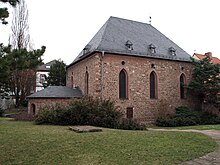
Mainz, previously known in English as Mentz or Mayence, is the capital and largest city of Rhineland-Palatinate, Germany.
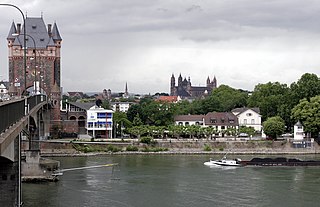
Worms is a city in Rhineland-Palatinate, Germany, situated on the Upper Rhine about 60 km (40 mi) south-southwest of Frankfurt am Main. It had about 82,000 inhabitants as of 2015.

A synagogue, sometimes referred to by the Yiddish term shul and referred to by Reform communities as a temple, is a Jewish house of worship. Synagogues have a place for prayer, where Jews attend religious services or special ceremonies, have rooms for study, social hall(s), administrative and charitable offices, classrooms for religious school and Hebrew school, sometimes Jewish preschools, and often have many places to sit and congregate; display commemorative, historic, or modern artwork throughout; and sometimes have items of some Jewish historical significance or history about the synagogue itself on display.

Kristallnacht (German pronunciation: [kʁɪsˈtalnaχt] ) or the Night of Broken Glass, also called the November pogrom(s) (German: Novemberpogrome, pronounced [noˈvɛm.bɐ.poˌɡʁoːmə] ), was a pogrom against Jews carried out by the Nazi Party's Sturmabteilung (SA) paramilitary and Schutzstaffel (SS) paramilitary forces along with some participation from the Hitler Youth and German civilians throughout Nazi Germany on 9–10 November 1938. The German authorities looked on without intervening. The name Kristallnacht (literally 'Crystal Night') comes from the shards of broken glass that littered the streets after the windows of Jewish-owned stores, buildings, and synagogues were smashed. The pretext for the attacks was the assassination of the German diplomat Ernst vom Rath by Herschel Grynszpan, a 17-year-old German-born Polish Jew living in Paris.

Hildesheim is a city in Lower Saxony, Germany with 101,693 inhabitants. It is in the district of Hildesheim, about 30 km (19 mi) southeast of Hanover on the banks of the Innerste River, a small tributary of the Leine River.

Speyer, historically known in English as Spires, is a city in Rhineland-Palatinate in Germany with approximately 50,000 inhabitants. Located on the left bank of the river Rhine, Speyer lies 25 km south of Ludwigshafen and Mannheim, and 21 km south-west of Heidelberg. Founded by the Romans, it is one of Germany's oldest cities. Speyer Cathedral, a number of other churches, and the Altpörtel dominate the Speyer landscape. In the cathedral, beneath the high altar, are the tombs of eight Holy Roman Emperors and German kings.

Mainz Cathedral or St. Martin's Cathedral is located near the historical center and pedestrianized market square of the city of Mainz, Germany. This 1000-year-old Roman Catholic cathedral is the site of the episcopal see of the Bishop of Mainz.
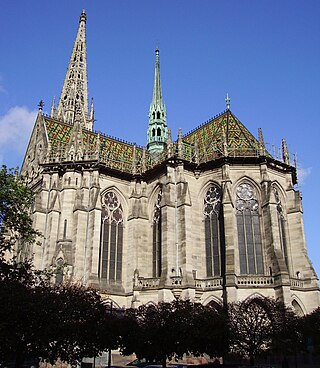
The Gedächtniskirche der Protestation is a United Protestant church of both Lutheran and Reformed confessions in Speyer, Rhineland-Palatinate, Germany, that commemorates the Protestation at Speyer in defense of the evangelical faith, specifically Lutheranism. Built between 1893 and 1904, the church was constructed in memory of the protest that took place at the Diet of Speyer by the Protestant rulers of the Holy Roman Empire in 1529. The tower is the tallest bell tower in the whole Palatinate at 100 metres (330 ft).

St Peter's Cathedral is a Roman Catholic church and former cathedral in Worms, southern Germany.

Speyer Cathedral, officially the Imperial Cathedral Basilica of the Assumption and St Stephen, in Latin: Domus sanctae Mariae Spirae in Speyer, Germany, is the seat of the Roman Catholic Bishop of Speyer and is suffragan to the Roman Catholic Archdiocese of Bamberg. The cathedral, which is dedicated to St. Mary, patron saint of Speyer and St. Stephen is generally known as the Kaiserdom zu Speyer. Pope Pius XI raised Speyer Cathedral to the rank of a minor basilica of the Roman Catholic Church in 1925.
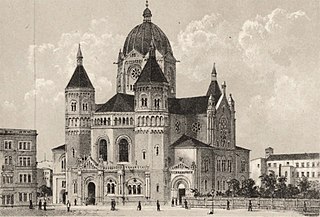
The New Synagogue was the largest synagogue in Breslau, Germany. It was one of the largest synagogues in the German Empire and a centre of Reform Judaism in Breslau. It was built in 1865–1872, and designed by Edwin Oppler. It was burnt down during the Kristallnacht pogrom which swept across Nazi Germany on 9–10 November 1938.

The Jewish courtyard in Speyer, is an historic and archeological site located in the inner city of Speyer, Germany. Built in stages between 1104 and the 14th century, the courtyard contains some of the oldest and best-preserved Jewish community buildings. Along with the other ShUM-cities of Worms and Mainz, Speyer was the hometown of one of the most important Jewish communities in Middle Ages in northern Europe. Because of its historical importance and its testimony to the European Jewish cultural tradition, the Jewish courtyard was inscribed on the UNESCO World Heritage List in 2021.
Imperial cathedral is the designation for a cathedral linked to the Imperial rule of the Holy Roman Empire.

The Jewish Cemetery in Worms or Heiliger Sand, in Worms, Germany, is usually called the oldest surviving Jewish cemetery in Europe, although the Jewish burials in the Jewish sections of the Roman catacombs predate it by a millennium. The Jewish community of Worms was established by the early eleventh century, and the oldest tombstone still legible dates from 1058/59. The cemetery was closed in 1911, when a new cemetery was inaugurated. Some family burials continued until the late 1930s. The older part still contains about 1,300 tombstones, while the newer part contains more than 1,200. The cemetery is protected and cared for by the city of Worms, the Jewish community of Mainz-Worms, and the Landesdenkmalamt of Rhineland-Palatinate. The Salomon L. Steinheim-Institute for German-Jewish History at the University of Duisburg-Essen has been documenting and researching the site since 2005. Because of its cultural importance and preservation, the Jewish Cemetery was inscribed on the UNESCO World Heritage List in 2021.

The Alte Synagoge in Erfurt, Germany, is one of the best preserved medieval synagogues in Europe, its oldest parts dating back to the late 11th century. Most parts of the building date from around 1250–1320. It is thought to be the oldest synagogue building intact to its roof still standing in Europe and the world.
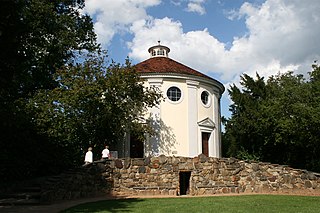
The Wörlitz Synagogue is a synagogue built in 1790 by order of Duke Leopold III of Anhalt-Dessau. It is located within the Dessau-Wörlitz Garden Realm, a UNESCO World Heritage Site since 2000.

The history of the Jews in Speyer reaches back over 1,000 years. In the Middle Ages, the city of Speyer, Germany, was home to one of the most significant Jewish communities in the Holy Roman Empire. Its significance is attested to by the frequency of the Ashkenazi Jewish surname Shapiro/Shapira and its variants Szpira/Spiro/Speyer. After many ups and downs throughout history, the community was totally wiped out in 1940 during the Holocaust. With the fall of the Iron Curtain in 1989 Jews again settled in Speyer and a first assembly took place in 1996.

The White Stork Synagogue is a nineteenth-century synagogue in Wrocław, Poland. Rededicated in 2010 after a decade-long renovation, it is the religious and cultural centre of the local Jewish community, under the auspices of the Union of Jewish Religious Communities in Poland. It is the only synagogue in Wrocław to have survived the Holocaust.
